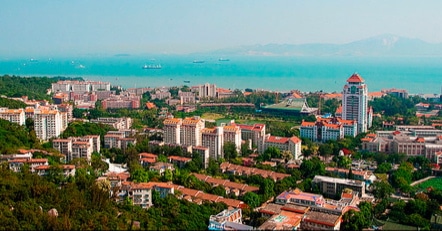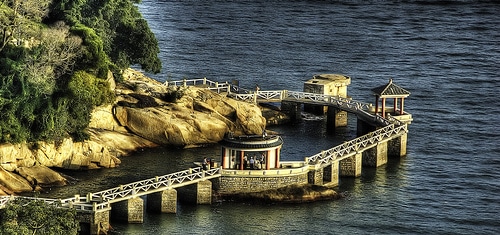An often-overlooked travel destination, the harbor city of Xiamen is one of the most prosperous — and most pleasant —cities in China.
In fact, the tourist-friendly city’s clean and attractive beaches, botanical gardens, waterfront promenades, and parks — combined with its booming economy and nice weather — have helped earn Xiamen the reputation of having the best all-around standard of living in China.
In addition to becoming a top domestic tourist attraction, the city has also become popular as a party town among young ex-pats. Sometimes referred to as “Shanghai’s little sister,” Xiamen’s thriving nightlife and chic restaurant scene — essentially non-existent ten years ago — has exploded with the region’s fortunes.
Located in the wealthy Fujian province, Xiamen’s fortunes took off after it was declared a Special Economic Zone (SEZ) in the 1980’s. And thanks to Taiwanese investment that continues to flood in from the other side of the Taiwan Strait, the province has become one of the wealthiest in China.
But the crown jewel of Xiamen’s tourist appeal is the small, tranquil island of Gulangyu, a 5-minute ferry from Xiamen’s wharf. Only about a square mile (2 sq km), Gulangyu island’s quirky streets and alleys, tourist shops and restaurants, clean beaches and waterfront views are immensely fun to explore on foot.
A former international settlement once home to 14 foreign consulates, Gulangyu is unique in its undisturbed colonial architecture and 19th century European flavor. Another unique and very welcome aspect of this mellow island is that motorized vehicles are banned (which means no honking, pollution or dodging traffic!).
Unless you’re main objective is to hit the clubs and fancy restaurants in Xiamen, my recommendation is to visit Xiamen but to stay on Gulangyu, which is home to a good and cheap hostel, as well as a good supply of mid-range accommodation. If you’re a fan of wandering back streets and observing daily life like me, you’ll love this gorgeous and atmospheric island (the first time I visited Gulangyu I ended up staying for an entire week).
Overview
Here are some of the attractions that make Xiamen & Gulangyu Island so popular with natives and international visitors, as well as some important general information to know for making your trip more enjoyable:
- Chinese: 鼓浪屿Gǔlàngyǔ /goo-laang-yoo/ ‘Drum Wave Islet’
- Area: 1.8 sq. km. (0.7 sq. mi.)
- Age: settled in 960 during the Song Dynasty
- Features: a vehicle-free zone, China National Tourism Administration AAAAA Scenic Area
- Popular activities: beach water sports, shopping, visiting museums, and viewing dazzling ocean inspired sunrises
- Must sees: Piano Museum, Shuzhuang Garden, Huaijiu Gulangyu Museum, and Sunlight Rock Scenic Area
- Catered to: young families, couples and people who want a break from city life and can get around well on foot
- Time needed: at least 4 hours, and it is ideal for weekend escapes
More Info & History
Smaller but much more attractive than Fuzhou, the capital of the Fujian province, Xiamen (known as Amoy in the 19th century) stands out from the bland industrial townships of the region. Only a stone’s throw from Taiwan, the Fujian province has historically been linked to Taiwan by both proximity and a common dialect.
Along with neighboring Guangdong and Zhejiang provinces, the Fujian province spearheaded the emigration of Chinese overseas starting in the 1980s.
Curiously, a disproportionate number of Chinese living in the US (who emigrated both legally and through “snakeheads”) are originally from the Fujian province. It would be tantamount to finding out the most Americans living in China all originally came from Virginia.
By Chinese standards, Xiamen is a new city, with a history that dates back to only the 12th century. It was first settled by Song dynasty (960-1279AD) but didn’t become significant port until the Ming dynasty.
Xiamen’s most important historical date occurred in 1841, when the British forced its port open after the Opium War. Not long afterwards, Gulangyu was designated an International Settlement for Europeans and Japanese (until the end of WWII). A foreign community was soon established on Gulangyu, which today is a museum piece of colonial architecture. Of particular architectural interest are the former British and German consulates and Roman Catholic Church.
Some Gulangyu tourist attractions worth noting: the highest point on the island is the view over Gulangyu on Sunlight Rock, which is dedicated to the rebel pirate Koxinga, who famously held out against the encroaching Manchus for years. Located next to the pier is the Xiamen Seaworld, which is home to an assortment of sharks, dolphins, penguins, seals and tropical fish.
Music lovers will also appreciate Gulangyu, which—thanks to Christian missionaries—has more pianos per capita than any place in China (about one piano in five homes).
Best Times to Visit
Luckily, the island’s sea breezes and tropical temperatures attract visitors year round. Although, overly crowded beaches and shopping areas are the only complaints that many visitors seem to have when they arrive on Gulangyu.
Therefore, try avoiding visiting the popular island during China’s public holidays (especially May Day and National Day) or on the weekends.





